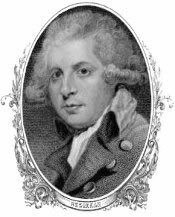Playwright. Born Dublin. Pupil at Harrow School 1762-8. Married Elizabeth Linley at St Marylebone Church in 1773. 1780-5 they lived in the grand house "The Grove" in Harrow, immediately north-east of St Mary's Church. The associated stables are still named for him. His plays include: The Rivals (1775), School for Scandal (1777). Died London.
This section lists the memorials where the subject on this page is commemorated:
Richard Brinsley Sheridan
Commemorated ati
R. B. Sheridan - Hertford Street
Richard Brinsley Sheridan, 1751 - 1816, dramatist and statesman lived here, 1...
R. B. Sheridan - Savile Row
Richard Brinsley Sheridan, dramatist, lived here, B: 1751, D: 1816. {Almost ...
Sheridan's Stables
"Form rooms" is what many public schools call their class rooms, after the fo...
Other Subjects
Members of the original National Theatre company
The National Theatre company was founded in July 1962 and the first performance was given at the Old Vic on 22 October 1963.There is a permanent exhibition about the history of the National Theatre...
Bill Kenwright
Born Liverpool. West End theatre producer and chairman of Everton Football Club.
Riverside Studios
Artistic venue. Originally a warehouse, it was taken over by the Triumph Film Company in 1933, and then acquired by BBC Television in 1954. Several episodes of 'Hancock's Half Hour' and 'Doctor Who...
Act of Parliament - 1751-2 - licensing
"Licensed pursuant to Act of Parliament of the Twenty fifth of King George the Second." This is a form of words that we have found at three 19th century places of entertainment, two physically and...
Previously viewed
City of London Coal Exchange
Designed by J. B. Bunning and opened in 1849 in Lower Thames Street, demolished in 1963. Our Picture source examines all the interesting buildings on this section of Lower Thames Street.
transportation to Australia
One of the (many) supposed origins of the word 'pom' for an Englishman, is that convicts were branded with the initials of 'Prisoner of Millbank'.
Paddington Recreation Ground
Noted as the earliest public athletic ground in London. It includes ten tennis courts, an athletics track, two artificial grass pitches, and two bowling greens.















Comments are provided by Facebook, please ensure you are signed in here to see them